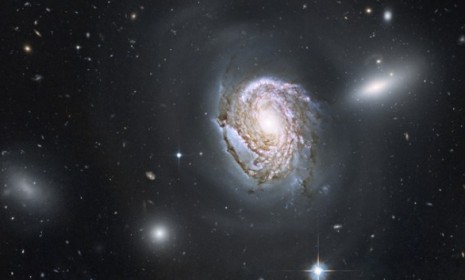2011's top mysteries of space
Between a giant planet made of diamond and a massive stellar explosion that shone with the light of a trillion suns, this was quite a year for stargazers

Space junkies were treated to a marquee year in 2011, thanks in part to powerful new telescopes that let astronomers peer into previously unseen parts of the universe. From potentially habitable new worlds to a crystallized planet that may very well be one gigantic diamond, a roundup of the year's most exciting intergalactic discoveries:
January
The year kicked off with a blast from the past when NASA's aging Hubble Space Telescope revealed the oldest galaxy on record. At a "stunning" 13.2 billion years old —the universe itself is only about 13.7 billion years old — the dim cluster of stars was born during an era "when stars and galaxies were first lighting up the universe."
The Week
Escape your echo chamber. Get the facts behind the news, plus analysis from multiple perspectives.

Sign up for The Week's Free Newsletters
From our morning news briefing to a weekly Good News Newsletter, get the best of The Week delivered directly to your inbox.
From our morning news briefing to a weekly Good News Newsletter, get the best of The Week delivered directly to your inbox.
February
A "gigantic underground moon cave" found by India's space agency caused a stir when scientists theorized that it might one day provide astronauts with "suitable housing." Predictably, the cave — roughly a mile long by about 400 feet wide — had many space lovers dreaming of a "small lunar city."
March
With more than 370,000 pieces of defunct shuttle parts circling the planet, NASA proposed a novel solution to our massive space junk problem: Lasers. The lasers wouldn't actually destroy garbage, but would send pulses of photon pressure to "nudge" objects out of the way of our skyward spacecraft. But that space junk didn't detract from March's grandest spectacle, which saw the moon make its closest approach to Earth since 1993, awing stargazers with a "dazzling 'supermoon" that was 14 percent bigger and 30 percent brighter than a typical moon viewing.
A free daily email with the biggest news stories of the day – and the best features from TheWeek.com
April
Space junkies were delighted by the brightest explosion ever witnessed by humans. A distant star was ripped apart by a super-massive black hole, creating a swirling "disk of plasma" that "shone with the light of a trillion suns."
May
Stargazers had a once-in-a-decade chance to catch a "beautiful gathering" of Mars, Jupiter, Venus, and Mercury all dancing together in the pre-dawn sky. It was like a "celestial summit meeting," said Joe Rao at Space.com.
June
An unusual burst of gamma-ray radiation flashing by our planet was thought to be a "mayday call" from a star being torn apart by a massive black hole. The "explosive event" took place in a small galaxy located within the Draco constellation some 3.8 billion light years away. The episode was quite rare — such events take place just "once every 100 million years."
July
Scientists discovered a giant cloud of water vapor hovering around a distant quasar. The cloud contained more than 4,000 times as much water as we have in the entire Milky Way Galaxy, confirming the longstanding notion that water exists in abundant supply throughout the universe.
August
Australian astronomers discovered a miraculous planet made entirely out of diamond. With a mass rivaling Jupiter — though 20 times as dense and half as big — the planet's "evolutionary history and amazing density" all suggest that it's made of crystalized carbon. Twinkle, twinkle, indeed.
September
Star Wars fans insisted that the newly discovered planet "Kepler-16b" ought to be called Tattooine, since it shares an usual feature with Luke Skywalker's home: Each planet orbits two suns. You'd think Kepler-16b would be pretty warm since it has two suns, but actually, the planet is brutally cold — with temperatures of minus 100 degrees Fahrenheit. There probably aren't many future Jedis living there.
October
Scientists realized that humanity survived a very close call in 1883. A 19th-century astronomer recorded 450 "heavenly objects passing across the face of the sun" — but it wasn't until October 2011 that scientists theorized that the objects were deadly comet fragments passing dangerously close to Earth, each "1,000 times more powerful than an atomic bomb." Good news, though: Humanity survived.
November
The White House took to its website to publicly reject conspiracy theories about the existence of UFOs, stating flatly that "there is no credible information to suggest that any evidence is being hidden from the public's eye." Also of note: NASA launched its Curiosity rover on a "long cruise to Mars." Curiosity is charged with finding — you guessed it — evidence of "microbial alien life."
December
Say hello to "Earth 2.0." Thanks to NASA's planet-hunting Kepler spacecraft, a world that could "conceivably harbor life" was found among the stars, sporting a "balmy temperature" of 72 degrees and a high likelihood of liquid water. But don't pack your bags yet. This comfy planet is 600 light years away.
-
 Heavenly spectacle in the wilds of Canada
Heavenly spectacle in the wilds of CanadaThe Week Recommends ‘Mind-bending’ outpost for spotting animals – and the northern lights
-
 Facial recognition: a revolution in policing
Facial recognition: a revolution in policingTalking Point All 43 police forces in England and Wales are set to be granted access, with those against calling for increasing safeguards on the technology
-
 Codeword: December 14, 2025
Codeword: December 14, 2025The daily codeword puzzle from The Week